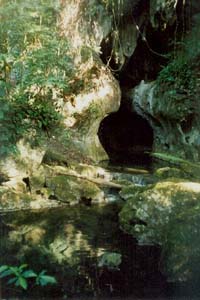Her face still haunts me five years later. I can still see the image of her crystal-encrusted skull with the jaw open, frozen in a silent scream. The rest of the skeleton was perfectly preserved in stone, arms askew above her head and legs spread apart. The preservation was so complete that you could make out the individual bones of the fingers. Above her head lay a beautifully carved jade axe. Was it used in her murder? |
|||
|
|||
Actun Tunichil Muknal was a major ceremonial site to the Maya.
Mapping, documenting, and preserving the remains in the cave has
been an on-going process by archaeologists for the last 6 years.
The cave was named for the stone altar discovered over ½
mile into the cave. On a ledge forty feet above the underground
river, an altar was constructed over 1000 years ago. Two slate
stelae or monuments were placed upright within a grouping of broken-off
cave formations. The four foot long stelae represented objects
used in the bloodletting rituals, obsidian blades and stingray
spines. In ancient Mayan times, the high priest would puncture
a body part and let the blood drip onto a piece of bark inside
a bowl. The bark would then be burned so that the smoke would
rise to the heavens as homage to the gods. The objects of this
ceremony were found scattered around the altar, obsidian blades,
elaborately decorated bowls, and faces carved into slate slabs. |
|||
|
|
In
the far reaches of the chamber, you climb vertically twenty
feet up to an alcove. It is here that you gaze upon the girl's
skeleton. You can't help but be mystified by the sight. Everyone
quietly leaves the chamber, wondering what happened at this
site a thousand years ago.
Actun
Tunichil Muknal is now open to the adventurous public. This
wondrous underground archaeological site is now a living museum.
The human remains and artefacts would not have as much importance
if removed to a display cabinet. By seeing these objects in
their original context, the ecotourist can appreciate what it
meant to the ancient Maya. All photos provided by Dr. Bruce Minkin. All rights reserved. |




